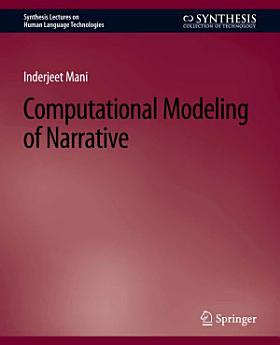Computational Modeling of Narrative
ພ.ພ. 2022 · Springer Nature
ປຶ້ມອີບຸກ
124
ໜ້າ
reportບໍ່ໄດ້ຢັ້ງຢືນການຈັດອັນດັບ ແລະ ຄຳຕິຊົມ ສຶກສາເພີ່ມເຕີມ
ກ່ຽວກັບປຶ້ມ e-book ນີ້
The field of narrative (or story) understanding and generation is one of the oldest in natural language processing (NLP) and artificial intelligence (AI), which is hardly surprising, since storytelling is such a fundamental and familiar intellectual and social activity. In recent years, the demands of interactive entertainment and interest in the creation of engaging narratives with life-like characters have provided a fresh impetus to this field. This book provides an overview of the principal problems, approaches, and challenges faced today in modeling the narrative structure of stories. The book introduces classical narratological concepts from literary theory and their mapping to computational approaches. It demonstrates how research in AI and NLP has modeled character goals, causality, and time using formalisms from planning, case-based reasoning, and temporal reasoning, and discusses fundamental limitations in such approaches. It proposes new representations for embedded narratives and fictional entities, for assessing the pace of a narrative, and offers an empirical theory of audience response. These notions are incorporated into an annotation scheme called NarrativeML. The book identifies key issues that need to be addressed, including annotation methods for long literary narratives, the representation of modality and habituality, and characterizing the goals of narrators. It also suggests a future characterized by advanced text mining of narrative structure from large-scale corpora and the development of a variety of useful authoring aids. This is the first book to provide a systematic foundation that integrates together narratology, AI, and computational linguistics. It can serve as a narratology primer for computer scientists and an elucidation of computational narratology for literary theorists. It is written in a highly accessible manner and is intended for use by a broad scientific audience that includes linguists (computational and formal semanticists), AI researchers, cognitive scientists, computer scientists, game developers, and narrative theorists. Table of Contents: List of Figures / List of Tables / Narratological Background / Characters as Intentional Agents / Time / Plot / Summary and Future Directions
ກ່ຽວກັບຜູ້ຂຽນ
Inderjeet Mani, who currently volunteers with the Children's Organization of Southeast Asia, was formerly a Visiting Scholar at the Department of Computer Science, Brandeis University, a Senior Principal Scientist at The MITRE Corporation, a Visiting Fellow at the Computer Laboratory at the University of Cambridge, and an Associate Professor at the Department of Linguistics at Georgetown University. He has served on the editorial boards of Computational Linguistics and Natural Language Engineering, and has published over 90 peer-reviewed papers, and seven books, including The Imagined Moment (University of Nebraska Press, 2010), a work on time, narrative, and computation that is addressed to a non-specialist audience. He has also published numerous short stories.
ໃຫ້ຄະແນນ e-book ນີ້
ບອກພວກເຮົາວ່າທ່ານຄິດແນວໃດ.
ອ່ານຂໍ້ມູນຂ່າວສານ
ສະມາດໂຟນ ແລະ ແທັບເລັດ
ຕິດຕັ້ງ ແອັບ Google Play Books ສຳລັບ Android ແລະ iPad/iPhone. ມັນຊິ້ງຂໍ້ມູນໂດຍອັດຕະໂນມັດກັບບັນຊີຂອງທ່ານ ແລະ ອະນຸຍາດໃຫ້ທ່ານອ່ານທາງອອນລາຍ ຫຼື ແບບອອບລາຍໄດ້ ບໍ່ວ່າທ່ານຈະຢູ່ໃສ.
ແລັບທັອບ ແລະ ຄອມພິວເຕີ
ທ່ານສາມາດຟັງປຶ້ມສຽງທີ່ຊື້ໃນ Google Play ໂດຍໃຊ້ໂປຣແກຣມທ່ອງເວັບຂອງຄອມພິວເຕີຂອງທ່ານໄດ້.
eReaders ແລະອຸປະກອນອື່ນໆ
ເພື່ອອ່ານໃນອຸປະກອນ e-ink ເຊັ່ນ: Kobo eReader, ທ່ານຈຳເປັນຕ້ອງດາວໂຫຼດໄຟລ໌ ແລະ ໂອນຍ້າຍມັນໄປໃສ່ອຸປະກອນຂອງທ່ານກ່ອນ. ປະຕິບັດຕາມຄຳແນະນຳລະອຽດຂອງ ສູນຊ່ວຍເຫຼືອ ເພື່ອໂອນຍ້າຍໄຟລ໌ໄໃສ່ eReader ທີ່ຮອງຮັບ.




